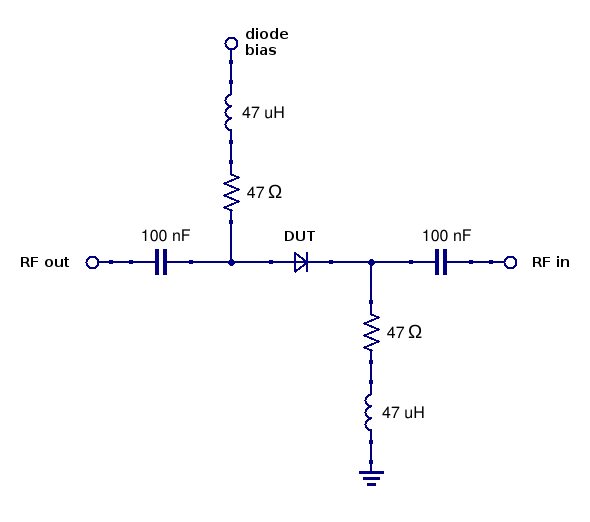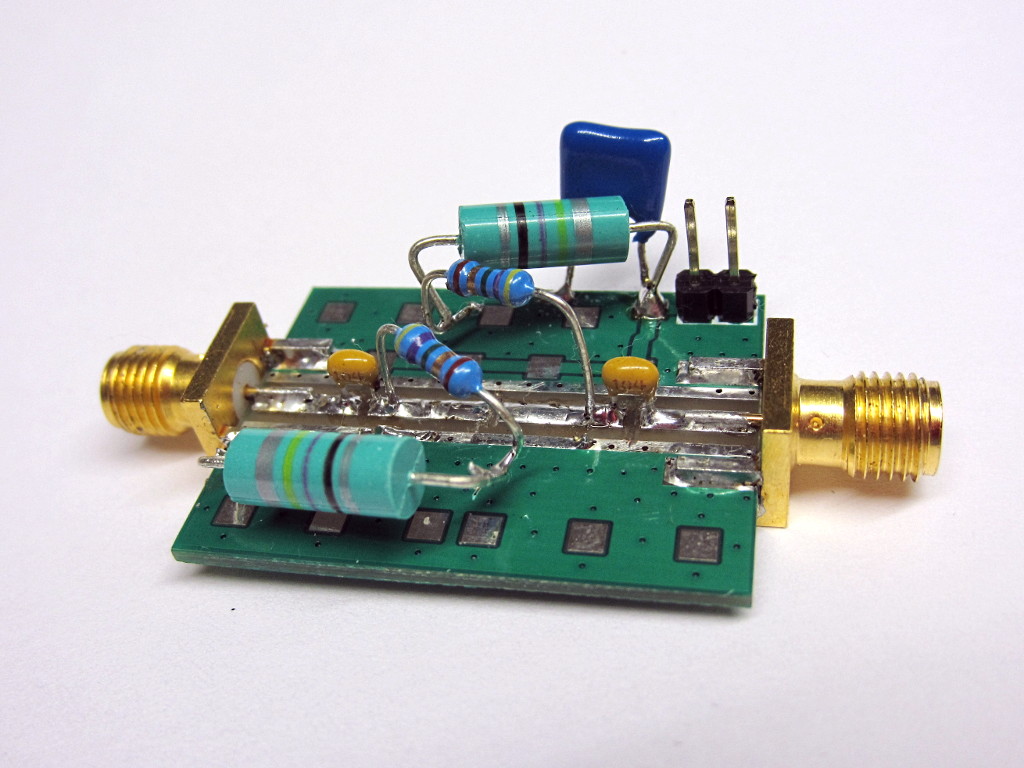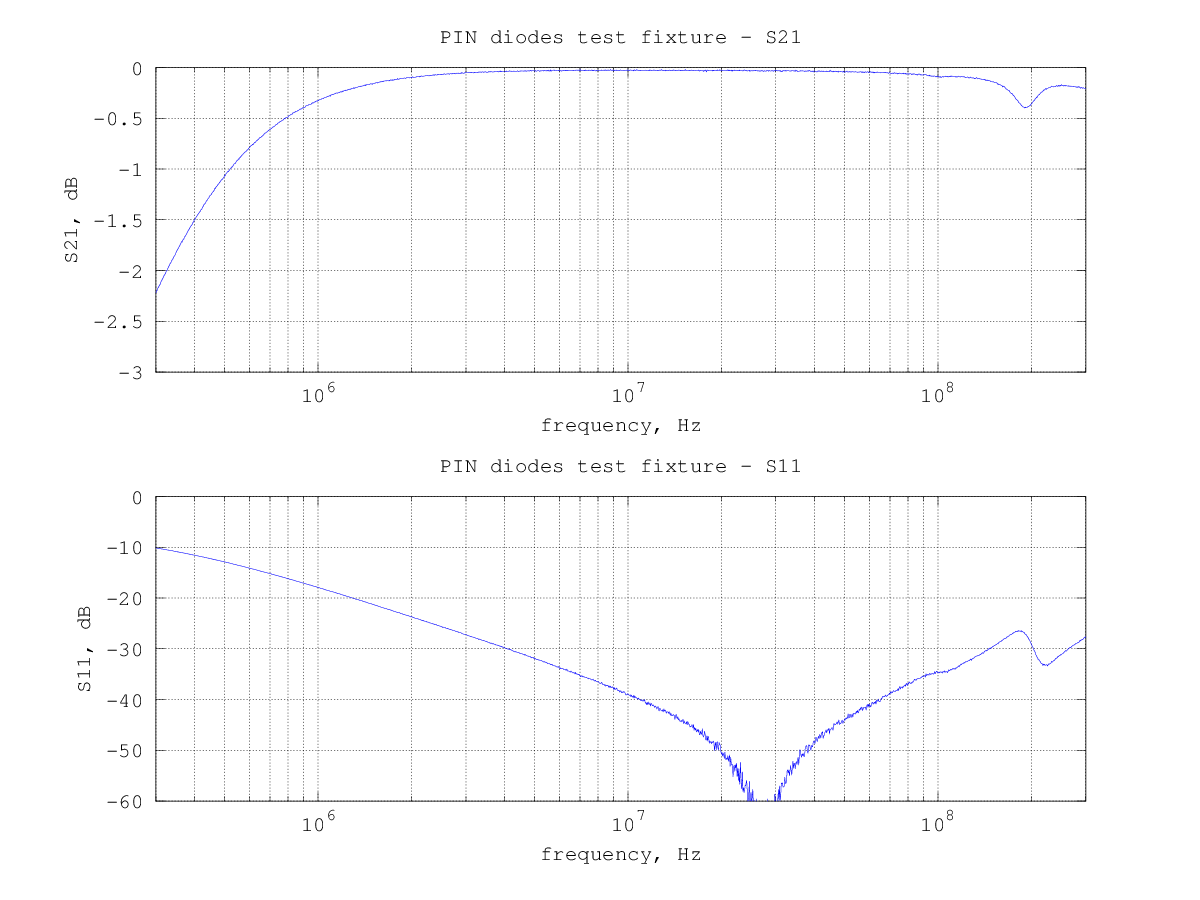IN3OTD's web site
...under perpetual construction.

Measurements on (pseudo-) PIN diodes
There have been some discussions in the Hermes-Lite SDR group about using PIN diodes, or normal diodes as PIN diodes, for switching the QRP TX output.
Since I found very little actual data on the internet about how well standard diodes perform when used as switch for QRP amplifiers, I did some measurements on a few diodes.
The test fixture
Using one of the small test PCBs I have done some time ago, I put together a simple test fixture, to be able to measure the diodes behavior with different forward and reverse bias.
The schematic is quite simple, a couple of inductors and series resistors for biasing the diode under test and capacitors to couple the RF and remove the DC bias on the test ports. The inductors used are some nice 47 μH made by Vishay, apparently now no longer in production. The inductors resonances are well above the HF band of interest here, but nevertheless I have added the two 47 Ω resistors on the signal side to dump any unwanted resonance.

The test PCB was originally designed with SMD components in mind, not thinking that also some bigger leaded component could be used:

With a short circuit in place of the DUT, the test fixture losses and return loss were measured:

at the lower end there are some mismatch losses due to the low inductors reactance, but at 1.8 MHz the losses are already quite low. In the HF band the losses are very low, as expected and only in the VHF region some ripple can be seen, due to the inductors parasitic resonances.
The test setup
The test fixture was connected to the output of a QRP PA (the QRP-PA2008), equipped with an output low-pass filter, and terminated to a 50 Ω power attenuator. The attenuator output was connected to a spectrum analyzer.
For the first test a continuous carrier was transmitted, the PA output power sweeped from 1 mW to 10 W and the output spectrum amplitude at the fundamental and the harmonics was recorded.
A similar power sweep was tone with a two-tone signal and the IMD products amplitude was generated.
The measurements above were repeated for a few different bias currents.
Since the PA used is not particularly clean, the same measurements were done also without the diode test fixture to establish a performances baseline.
The diodes S-parameters were measured with a small-signal amplitude (-20 dBm) for different forward and reverse bias conditions.
A measurement that still needs to be done is the diode reverse isolation at high power.
Here is a list of the diodes tested:
- Through-hole components:
- 1N4007, Fairchild - Mouser 512-1N4007_Q (obsoleted)
- GP10Y, Vishay - Mouser GP10Y-E3-54
- 1N5408, Kingtronics (datasheet)
- Surface mount components:
- S1FLM, Vishay - Mouser 78-S1FLM-GS08
- CMAD6001, Central Semiconductor - Mouser 610-CMAD6001
- S07M, Vishay - Mouser 78-S07M
- M7, sold as "Toshiba" on eBay but not listed on the Toshiba website.
- MRA4007, ON Semiconductor - Digikey MRA4007T3GOSCT-ND
- S1M, Vishay - Digikey S1M-E3/61TGICT-ND
Quick summary
Of the through-hole diodes tested, the venerable 1N4007 shows a low distortion at 1.8 MHz, but its reverse capacitance is not quite low. The GP10Y is comparable, it needs a bit more forward current to work as well. The 1N5408 shows a poor isolation, due to its high reverse capacitance.
For the SMD diodes, the CMAD6001 seems not really to behave as a PIN, at 1.8 MHz its performances are poor when forward biased. On the other end its reverse-bias capacitance is rather low.
The S1FLM and S07M behaves quite similar, still not good on the lower end of the HF.
Finally, the M7 diode seems really quite like a SMD 1N4007, as it's sometimes advertised, even with slightly lower losses and lower capacitance, and could probably be successfully used to switch a QRP TX. Very similar to the 1N4007 are also the MRA4007 and S1M.